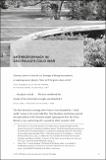| dc.contributor.author | Jones, Caroline A | |
| dc.date.accessioned | 2021-10-27T20:05:55Z | |
| dc.date.available | 2021-10-27T20:05:55Z | |
| dc.date.issued | 2013 | |
| dc.identifier.uri | https://hdl.handle.net/1721.1/134638 | |
| dc.description.abstract | © 2013 ARTMargins and the Massachusetts Institute of Technology. The first biennial founded outside Venice opened in São Paulo Brazil in 1951, providing a fulcrum between "dependency" and "developmentalism" (to use economic terms). In terms of art history, it presents a useful anomaly in which an international style ("concrete abstraction," a European import) was used simultaneously to eradicate local difference and to declare a cosmopolitan, up-to-date Brasilidade (Brazilianness). More crucially, I argue that the São Paulo Bienal was the precondition for the newly rigorous conceptualism that followed, as Brazilian artists in the late '60s rejected "Concretismo" to craft a new world picture, radically transforming margin and center through the profoundly theoretical practice of antropofagia - cultural cannibalism. | |
| dc.language.iso | en | |
| dc.publisher | MIT Press - Journals | |
| dc.relation.isversionof | 10.1162/ARTM_A_00031 | |
| dc.rights | Article is made available in accordance with the publisher's policy and may be subject to US copyright law. Please refer to the publisher's site for terms of use. | |
| dc.source | MIT Press | |
| dc.title | Anthropophagy in São Paulo's Cold War | |
| dc.type | Article | |
| dc.contributor.department | Massachusetts Institute of Technology. Department of Architecture | |
| dc.relation.journal | ARTMargins | |
| dc.eprint.version | Final published version | |
| dc.type.uri | http://purl.org/eprint/type/JournalArticle | |
| eprint.status | http://purl.org/eprint/status/PeerReviewed | |
| dc.date.updated | 2019-08-07T12:48:19Z | |
| dspace.orderedauthors | Jones, CA | |
| dspace.date.submission | 2019-08-07T12:48:20Z | |
| mit.journal.volume | 2 | |
| mit.journal.issue | 1 | |
| mit.metadata.status | Authority Work and Publication Information Needed | |
